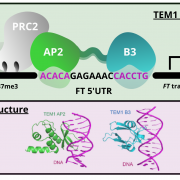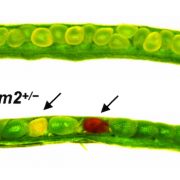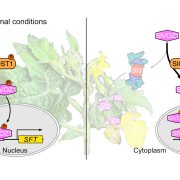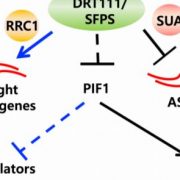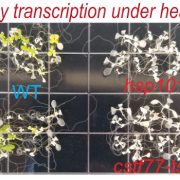Flowering Under Stress
Park H.J., Gamez-Arjona F., et al. show how plants reset the time of flowering under salinity stress. Plant Cell https://doi.org/10.1093/plcell/koac289
Background: For plants, extremes in the cardinal conditions of light, temperature, nutrients and water availability are major drivers of natural selection. Adaptive responses must be coupled to adjustments in the reproductive strategy to be favored by selection. In unfavorable environments, the transition to flowering is adjusted earlier or later to maximize the production of dormant structures (seeds) that can survive prolonged adverse episodes and eventually re-initiate a life cycle when conditions improve. Water and nutrient deprivation can quickly compromise survival and generally induce earlier flowering, whereas soil salinity reduces growth and delays flowering.
Question: What are the molecular mechanisms by which the plant Arabidopsis thaliana re-adjusts flowering time in response to salinity stress to secure reproductive success?

Findings: The protein GIGANTEA (GI) synchronizes flowering time with the photoperiodic and circadian rhythms. Salinity results in rapid degradation of GI protein and delayed flowering. We show that GI is selectively degraded in the cytoplasm but protected inside the nucleus by a mechanism that involves the addition of a fatty acid (palmitoylation) and nuclear import of the calcium-signaling protein SALT OVERLY SENSITIVE3/ CALCINEURIN B-LIKE4 (SOS3/CBL4). Moreover, nuclear SOS3/CBL4 participates in the transcriptional complex that regulates CONSTANS, a key gene governing flowering time, thereby creating a molecular switch that integrates calcium signaling, spatial segregation of proteins, and transcriptional regulation to adjust the time of flowering in a saline environment.
Next steps: The timing of flowering and the environmental resilience of crops are critical traits in agriculture. Understanding how stress responses dictate when plants flower, and produce their fruits and seeds, will be critical for food security under the threat of climate change.
Reference:
Park H.J., Gamez-Arjona F., et al. (2022). S-acylated and nucleus-localized SALT OVERLY SENSITIVE3/ CALCINEURIN B-LIKE4 stabilizes GIGANTEA to regulate Arabidopsis flowering time under salt stress. Plant Cell. https://doi.org/10.1093/plcell/koac289


